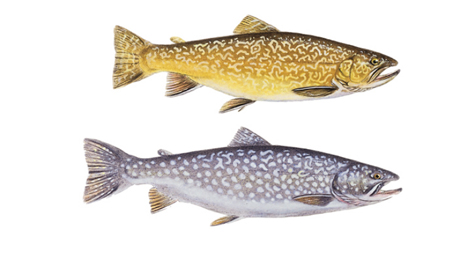A cross between Lake Trout and Brook Trout, the splake has characteristics of both parents. Splake often look like brook trout with a moderately forked tail.
Common Names: Splake, wendigo, F1 splake
Habitat
Splake have been introduced by the Ministry of Natural Resources into a variety of waters throughout the province as part of their stocking programs. Splake perform best in small waterbodies that remain relatively cool throughout the year. Water clarity of at least five meters in depth is desirable for optimal growth.
Spawning Patterns
Hatchery raised splake are reared by fertilizing lake trout eggs with brook trout sperm. Where splake have been known to naturally reproduce, they exhibit characteristics of both lake and brook trout. Second and third generations of splake in a lake are usually poorly adapted to the local conditions and have decreased survival rates. Maturity is reached at three years. Spawning occurs throughout October and November, depending on water temperatures, and lasts over a three-week period. They can spawn in either daylight or darkness.
Diet
Much like brook trout, splake can eat a variety of foods but the most important are plankton, insects, crayfish and small fish.
Age and Size
A desirable characteristic of splake is that they grow more quickly than either of the parent species enabling them to reach a catchable size at a younger age. Stocked fish can live as long as 20 years but their offspring are usually less robust and have higher mortality rates. Splake may reach weights up to 20 lbs.
Fishing Tips
Splake are most active in the spring and fall when water temperatures are cool. At these times, fish are shallow and can be caught on a wide variety of presentations. Casting or trolling small spinners or minnow imitating baits can be productive at these times, as well as using fly fishing tackle. During the summer months, splake often suspend over deep water. Use your depth finder to locate the thermocline and troll around this depth.
Fish illustration ©CURTIS ATWATER (www.natureartists.com/atwaterc.htm)









